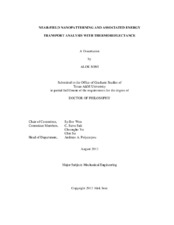| dc.contributor.advisor | Wen, Sy-Bor | |
| dc.creator | Soni, Alok | |
| dc.date.accessioned | 2013-12-16T20:00:46Z | |
| dc.date.available | 2015-08-01T05:48:26Z | |
| dc.date.created | 2013-08 | |
| dc.date.issued | 2013-05-31 | |
| dc.date.submitted | August 2013 | |
| dc.identifier.uri | https://hdl.handle.net/1969.1/151052 | |
| dc.description.abstract | Laser nano-patterning with near-field optical microscope (NSOM) and the associated energy transport analysis are achieved in this study. Based on combined experimental/theoretical analyses, it is found that laser nano-patterning with a NSOM probes strongly depend on the laser conditions and material properties of the target: the energy transport from the NSOM probes to the targets changes from pure optical to a combination of thermal and optical transport when the pulse duration of laser is increased from femtosecond to nanosecond. As a result, the mechanisms of nano-pattern formation on targets changes from nano-ablation to nano-oxidation/ recrystallization when the laser pulse duration is increased from femtosecond to nanosecond.
Also, with the laser nano-patterning experiments, thermal damage of NSOM probes is observed which can be attributed to the low transport efficiency (10-4 – 10-6) and associated heating of the metal cladding of NSOM probes. The heating of NSOM probes are studied with developed time harmonic and transient thermoreflectance (TR) imaging. From time harmonic TR when the NSOM probes are driven with continuous laser, it is found that the location of heating of NSOM probes is ~20-30µm away from the NSOM tip. The strength of the heating is determined by the laser power (linear dependence), wavelength of the laser (stronger with short A), and aperture size of NSOM probes (stronger when aperture size < A/2). From the transient TR imaging when the NSOM probes are driven with pulsed laser, it is found that the peak temperature of the NSOM probe shifts much closer to the tip. The possible reason for the change in the location of peak temperature when continuous laser is changed to pulsed laser can be attributed to the competition between the heat generation and dissipation rates at different location of the probe: the tip experiences highest temperature with pulsed heating as the entire heating processes is adiabatic. The tip also experiences highest heat dissipation rate due to its large surface-to-volume ratio which overcomes the heat generation at the tip under quasi-steady state resulting in shift of the hot spot. The knowledge obtained in this study can be important in the future design of more efficient NSOM probes and other nano-optic devices. | en |
| dc.format.mimetype | application/pdf | |
| dc.language.iso | en | |
| dc.subject | near-field optical microscope | en |
| dc.subject | NSOM | en |
| dc.subject | laser machining | en |
| dc.subject | thermoreflectance | en |
| dc.subject | laser ablation | en |
| dc.subject | nanopattern | en |
| dc.title | Near-Field Nanopatterning and Associated Energy Transport Analysis with Thermoreflectance | en |
| dc.type | Thesis | en |
| thesis.degree.department | Mechanical Engineering | en |
| thesis.degree.discipline | Mechanical Engineering | en |
| thesis.degree.grantor | Texas A & M University | en |
| thesis.degree.name | Doctor of Philosophy | en |
| thesis.degree.level | Doctoral | en |
| dc.contributor.committeeMember | Suh, Steve C. | |
| dc.contributor.committeeMember | Yu, Choongho | |
| dc.contributor.committeeMember | Su, Chin | |
| dc.type.material | text | en |
| dc.date.updated | 2013-12-16T20:00:46Z | |
| local.embargo.terms | 2015-08-01 | |


